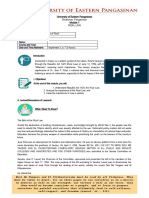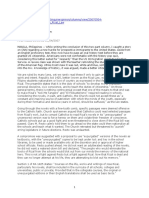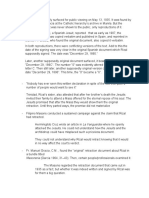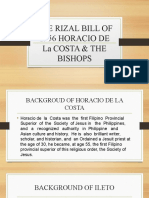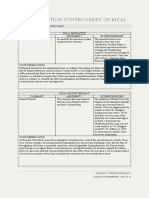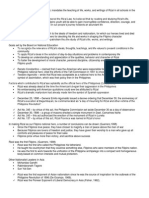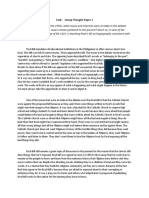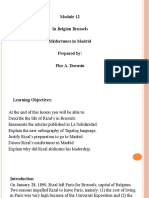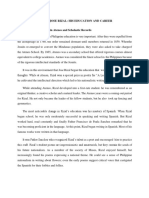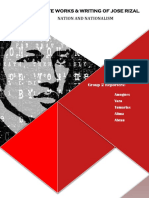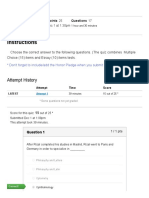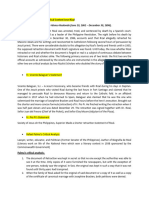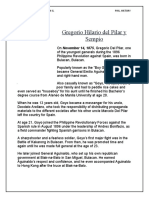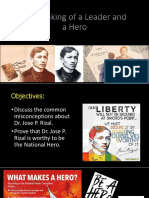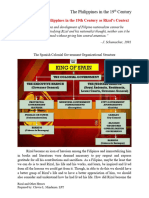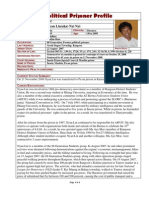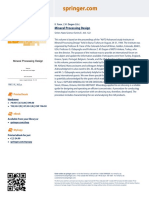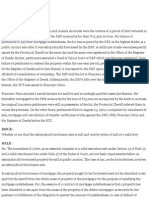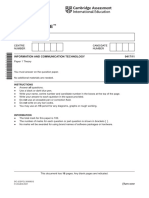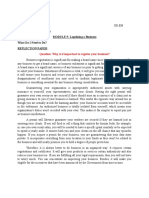Republic of the Philippines
CARLOS HILADO MEMORIAL STATE COLLEGE
Talisay City, Negros Occidental
Life and Works of Rizal
First Semester, SY 2021-2022
On Rizal’s Retraction
Prepared by: Ms. Charity Mae M. Dosayla
Assistant Professor
Did Rizal React then Retract?
Charity Mae Dosayla
Many events in Philippine history remain debated and unresolved even centuries after they have occurred.
Events in the last 24 hours of Rizal’s life are no exemptions from such deliberations, especially with regards to
whether he retracted his anti-Catholic writings and returned to the Catholic fold or remained steadfast and
loyal to the ideals and principles of Freemasonry. Catholic priests and Masonic brothers are the protagonists
of these two equally opposing forces. Rizal is a non-negligible figure in Philippine history for it was his writings
which inspired revolutionaries to instigate a bold move to reclaim our independence – acts which have
enshrined several of them to approbation on a national scale. The Filipinos’ undeterred march against their
oppressors also rippled among their Southeast Asian neighbors who also raised arms against their respective
European colonizers. Rizal’s influence, therefore, is not merely provincial but also international. To collect
Rizal in their side would thus bestow either the Catholic Church or the Masonry their highly-valued honor and
reputation. As with the Catholic Church, to establish that Rizal recanted his espousals and criticisms of the
friars would ‘repair the scandal’ that Rizal’s acts have caused (Rizal’s Retraction Letter, cited in Escalante,
2019, p.374). An affirmation of Rizal being a Catholic before his death would strengthen the Church’s hold of
its members while the opposite may cause demoralization particularly among members who afford Rizal with
much respect. It is therefore a worthwhile academic venture that we examine the testimonies of eyewitnesses
if we are to determine the closest possible explanation on the controversy. Before this examination, here is the
English translation of Rizal’s retraction letter
‘I declare myself a Catholic and in this Religion in which I was born and educated I wish to
live and die. I retract with all my heart whatever in my words, writings, publications, and conduct
has been contrary to my character as son of the Catholic Church. I believe and confess whatever
she teachers, and I submit to whatever she demands. I abominate Masonry, as the enemy which is
of the Church, and as a Society prohibited by the Church.
The Diocesan Prelate may, as the Superior Ecclesiastical Authority, make public this
spontaneous manifestation of mine in order to repair the scandal which my acts may have caused
and so that God and people may pardon me.
The Chief of the Picket
Juan del Fresno
Adjutant of the Plaza
Eloy Moure (Guerrero 1971, 458-459)
1 | CM DOSAYLA
�The Testimony of Fr. Vicente Balaguer Llacer
Below is an excerpt of the testimony of Fr. Vicente Balaguer Llacer, a Jesuit priest, he sworn in a notarial act
in Murcia, Spain on August 8, 1917:
“That, after Rizal was condemned to death, when the chaplain of the Royal Fort Santiago,
where the convict was, offered his services for so sad circumstances, the prisoner told him
that he appreciated his offering, but that he desired rather to be visited by the Fathers of
the Society of Jesus by who he had been educated. When he made this request, the Rev.
Father Superior, Father Pi, in compliance with the commission of His Grace, the Archbishop
had already sent Father Saderra, Rector of the Ateneo, and Father Luiz Viza to the fort.
When these fathers entered the fort that morning, December 29, 1896, Rizal received them
with sights of affection, and asked them whether some of those who had been his
professors were still there in Ateneo. They told him that Father Vilaclara only, who returned
to Manila, a few days before, remained. They told him that I was also in Manila, and he
asked that I go also, since I had been…. a Missionary in Dapitan where he dealt with me as
a friend. He was a very polite gentleman, and even friendly towards me.”
“At about ten o’clock in the morning, Father Vilaclara and I went to Fort Santiago, where
the chapel cell of the convict was. He received us with great affection and embraced us. I
think it convenient to point out that, when the Archbishop sent his commission to the
Ateneo, he remarked that, in case of conversion, before ministering the Sacraments to him,
Dr. Rizal should make a retraction of errors publicly professed by him in words and writings,
and a profession of the Catholic faith. TO this effect, when the Father Superior of the
Mission went to the Archbishop’s Palace, he brought by way of precaution a retraction and
profession of faith, concise, but including what he thought ought to be exacted from Dr.
Rizal. The Prelate read it, and declared it to be sufficient. He said, whoever, that he would
prepare or order to be prepared a more extensive one.
Before going to the Fort, I went to the Palace in order to receive orders and instructions
from the Prelate. The Archbishop gave me the formula of retraction and profession of faith,
composed by Rec. Father Pio Pi. He told me to wait for the other more extensive one; and to
present to the convict either of them, according to his personal disposition. At any rate, it
was enough to admit the shorter and concise formula of Father Pio, since His Grace
considered it sufficient in order to administer the Holy Sacraments to him.
Therefore, when we, the two Fathers, met him in the chapel, after exchanging greetings
with him and talking on various matters, I, who know the history and errors contained in his
books, I order to fulfill our delicate mission, asked Rizal to give an explanation of his ideas
on religion. At the outset he appeared a Protestant, because of certain phrases manifesting
love and respect for Jesus Christ. Nay, he came to say more or less explicitly that his rule of
faith was the word of God contained in the Sacred Scriptures. I tried to make him see false
and indefensible such a criterion was, in as much as without the authority of the Church he
could not be sure of the authenticity of the Holy Scriptures or of the book truly revealed by
God; how absolutely impossible it is for the individual reason to interpret at his will the
word of God. Then he declared himself openly a rationalist, or freethinker, unwillingly to
admit any other criterion of truth than the individual reason.
I then pointed out to him the absurdity of rationalism for the lack of instruction of the
immense majority of humankind, and for the absurd and monstrous errors professed by the
2 | CM DOSAYLA
�greatest sages of paganism. I tried to convince him with irrefutable arguments that there is
not, nor can there be, a more rational criterion than supernatural faith and divine
revelation, warranted by the infallible authority of the Church; that such is the clear
testimony of reason, history and motives of credibility offered with evidence by the Church.
Constrained by these invincible arguments, he came to say to me that he was guided by the
reason God had given him, adding with a self-possession that curdled my blood, that he
was going to appear thus before the tribunal of God, with a clear conscience for having
fulfilled his duty as rational man. When I attacked him with arguments of Catholic doctrine,
he began to expound the objections of the heretics and rationalists, a thousand times
refuted already.
We had to discuss the criterion or rule of faith, the authority of the Church, her infallibility
and divine teaching authority, the power of working miracles, the death penalty (a subject
of so burning an interest in those moments), the death of Ananias and Sapphira, the Holy
Scriptures, the Vulgate, Saint Jerome’s version, that of LXX, Purgatory Churches, the
argument of Balmes against them, the worship of Saints, and especially the extension of
Redemption, and many other objections of apologetics, a thousand times refuted with
irresistible arguments. When I attacked him with the logic and evidence of Catholic truth, I
told him with energy that if he did not yield his mind and his reason for the sake of faith, he
would surely be damned. Upon hearing this threat, tears gushed from his eyes, and he said:
‘No, I will not damn myself.’
‘Yes, I replied’,---- ‘you will go to hell, for, whether you like it or not, EXTRA ECCLESIAM
CATHOLICAM NULLA DATUR SALUS. Yes; out of the Catholic Church there is no salvation.
Truth is and cannot be but one. AS such, truth is uncompromising in all orders, and much
more so in religious order, which is the most transcendental.
Affected by this reproach, he said: --- ‘Look here, Father; if to please Your Reverence I would
say yes to everything and would sign everything you present to me without meaning it, I
would be a hypocrite and would offend God.’
‘Certainly,’--- I told him --- and we don’t want that. But believe me that it is a grief without
equal to see a beloved person obstinate in error, and to see that person about to be
damned and to be unable to prevent it. You take pride in being a sincere man; so believe us
that if by giving our blood and our lives we could achieve the salvation of your soul, right
now, we would give our lives and offer ourselves to be shot in lieu of you.’
‘But Father,,’ --- he replied with regret --- ‘what would you have me do, since it seems that I
cannot dominate my reason?’
‘Offer,’ I answered --- ‘offer to God the sacrifice of your self-love. Even if it be against the
voice of your reason, ask God the grace of faith, which is a gift that God bestows
abundantly and is obtained infallibly by humble and persevering prayer. Only on your part,
you should not reject it.’
‘Well then, Father,’ ---- he said ---- ‘I promise you that I will spend the time that still remains
of my life, asking God for the grace of faith.’
3 | CM DOSAYLA
�‘Take a rest then,’ ---- I told him ---- ‘and ponder over what we have talked about. Have
recourse to the Lod, trusting in the infallible efficacy of prayer. Man’s heart is in the hands
of God.’
Then I went to the Ateneo, and thence I went with Father Viza to the Palace. There I
reported on the condition of the convict, who offered some hope for conversion, since he
had asked for the formula of retraction. Hence, I requested the Prelate for the formula he
had promised, and he told me that it was not yet finished. Soon he would send it to me.
It was already night when I arrived at the Fort. I found Rizal impatient. He asked for the
formula of the Prelate. This came at last, at about ten o’clock; upon knowing it, the convict
asked me for it insistently. Without letting me read it first, he called and asked me to read it
to him.
Both of us sat at a desk, where there was stationary and began to read it. Upon hearing the
first paragraph, he told me, ‘Father, do not proceed. That style is different from mine. I
cannot sign that, because it should be understood that I am writing it myself.’
I brought then the shorter and more concise formula of Father Pi. I read the first paragraph
and he said to me: ‘That style is as simple as mine. Don’t bother, Father, to read it all.
Dictate what I ought to profess or express, and I shall write, making in any case some
remarks.’
And thus it was done. As I suggested the idea, he proceeded to write with steady hand and
clear letters, making at times some observation of adding or adding a phrase. Certainly,
after the discussion, Dr Rizal was yielding to the impulse of grace, since he retired into
himself and prayed as he had promised. Thus he appeared to be while writing his
retraction.
At the beginning, the formula stated: ‘I declare myself a Catholic and in this religion I wish
to live and die.’ Dr. Rizal told me: ‘Please add’ (and he was already writing, after the word
‘religion’): ‘in which I was born and educated’ as if he wished to make his Catholic
education known.
I continued reading. He continued assenting and writing with some brief indication of his
own, and explanation on my part. He assented then, and he admitted everything expressed
in the formula. When we came to the paragraph where Masonry was detested, he showed
some resistance to subscribe this sentence of the formula: ‘I abominate Masonry as a
society reprobated by the Church.’ He gave me this reason. He said that he had known
Masons who were very bad: but those with whom he had been acquainted in London were
businessmen and seemed to be good persons. It seemed also that he meant to say that the
kind of Masonry in the Philippines did not require the abjuration of the Catholic faith,
although I ma not quite sure of this. Anyhow, it seems that Dr. Rizal was admitted, at all
events, into some of the first degrees only, in which the members are not obliged to abjure
the faith explicitly. After some observations, he himself proposed to write and to sing, as he
did, this formula: ‘I abominate Masonry as the enemy of the Church.’ And in this way he
wrote it. I continued assenting, with some little observations.
4 | CM DOSAYLA
� So, for instance, it was said at the end: ‘The Diocesan Prelate may’… and he wanted to add:
‘as the superior ecclesiastical authority, make public this my manifestation.’ At the words
‘my manifestation’ he asked me to allow him to add ‘spontaneous and voluntary’ and he
told me then with great asseveration: ‘Because, believe me, Father, I am doing this heartily;
otherwise, I would not do it.
Well then, ‘I told him, ‘you may put spontaneous and it is enough.’ He finished the writing,
and thus it remained. It was half past eleven; it was dated December the twenty-ninth…
ThIs declaration or retraction was signed together with Dr. Rizal was Señor Fresno, Chief of
the Picket, and Señor Moure, Adjutant of the Plaza.
Finally, I declare and affirm that, a little before came out from the chapel, I left in the
company of Josephine Bracken and a sister of Rizal, from whom, after a while, I departed. I
was bringing with me Rizal’s own handwritten retraction signed by him and by the witness.
Before Rizal reached Bagumbayan, I went to the Ateneo and delivered the aforementioned
document to Father Pio PI, who that very day brought it to the Palace and handed it to
Archbishop Nozaleda. His Grace entrusted it to his Secretary, Reverend Tomas Gonzales
Feijoo, who kept it in the Secretary’s Office, in the chest of reserved documents. This last
fact I know through the testimony of His Grace, the Most Reverend Bernardo Nozaleda, and
of his Secretary. The other things I have declared I know as an eyewitness and because I
personally took part in the said events.
The Jesuit version of the retraction was based heavily on Fr. Vicente Balaguer’s account, who produced a
detailed description of events following Rizal’s alleged retraction. Fr. Balaguer’s account states that he and Fr.
Jose Villaclara visited Rizal in the latter’s prison cell on three occasions: (1) at 10’clock in the morning, during
when they and Rizal engaged in discussion on some articles of the Catholic faith: (2) at 3 o’clock in the
afternoon to convince Rizal to sign the retraction document; and (3) at 10 o’clock in the evening during when
they showed Rizal two retraction templates from Fr. Pio Pi. Fr. Balaguer confirmed that, after introducing minor
changes to the shorter template, Rizal signed the document before midnight (Torres, 2018, pp.139-141).
On the other hand, the Jesuits’ claim that Rizal recanted was repudiated by Friedrich Stahl in his letter to
Ferdinand Blumentritt, by Jose Alejandrino in his letter to expatriates in Hong Kong, and by the experience of
the Rizal family of not having seen the actual letter signed by Rizal despite the promise of the Jesuit priests
themselves (Escalante, 2019, p.374). Rizal’s original retraction letter was not presented by the Jesuit friars
following Rizal’s execution. Only copies of the letter were circulated to newspapers for publication.
Newspapers that circulated during the time of Rizal’s execution each published their own account of events a
day before and on the day of execution. Diario de Manila, La Voz Española, El Español, El Comercio, La
Oceania Española, El Imparcial and Heraldo de Madrid all published the same line of thought, only with
variations in specific details, that Rizal has retracted. It should be noted that while Rizal was imprisoned in his
cell in Fort Santiago, security was very stringent, that no one without the expressed consent of the Manila
Archbishop or the Governor-General be allowed entry inside Rizal’s prison cell. The admission of Jesuit priests
to visit Rizal and Rizal’s coming and going in the chapel or the contemplation room, might not have been
witnessed by these journalists. By extension, they might not have actually witnessed Rizal signing their stated
retraction letter. In other words, although they may have published the same idea, this is not based on first-
hand primary witness account. Rather, this was just a handed-over information by a person who might or
might not have vested interests on the outcomes of Rizal’s fate. Even if the person who gave them information
has no personal interest on Rizal, nevertheless, the issue that is to be pointed out is the reliability of the
information these newspapers presented. If Rizal’s retraction was an act highly valued by the Jesuit priests
and the Catholic Church as a whole and that which will redeem them from the scrutinizing eyes of Masons and
other members of the public at that time and in the course of history, showing the original retraction letter
5 | CM DOSAYLA
�where Rizal’s signature was affixed would redeem them and finally cement their claim. This would then lead
this controversy to rest.
The Finding of the “Original’ Signed Retraction of Rizal
Rizal’s original letter of retraction was said to have been found in 1935 by Fr. Manuel Garcia compiled in a
document entitled Masoneria. This letter received both approval and denial by academics who were given
authority to examine the document. Fr. Garcia presented the document to Monsignor Michael O’Doherty and
later to Carlos P. Romulo. Archbishop O’Doherty wanted to confirm their finding and requested Prof. H. Otley
Beyer, Professor of Anthropology of the University of the Philippines and a handwriting expert, to examine the
document and determine whether it was genuine or not. Prof. Beyer had this to say pertaining to the document
in a speech he delivered in a faculty symposium of UP.
‘Now, when I examined the document itself, of which I have a photograph here. I was not
satisfied because, while in this folder were three or four other letters signed by Rizal, they
did not satisfy me. So I said that I would not give a genuine opinion on the writing until I
had other letters and writings of Rizal to compare with that document; and so this
photograph was made and I took it away and examined it in comparison with probably 150
letters and documents in Rizal’s handwriting.
I would say off hand, from my experience of 30 or 40 years of examining handwriting
documents, that there is not the slightest doubt that evert word on that sheet of paper was
written by Jose Rizal except the signatures of the other witnesses below. The whole
document is in his formal handwriting.
We have now in my custody in the Museum letters of Rizal written to Prof. Ferdinand
Blumentritt. One of them is here, the last that he wrote the night before his execution.
Anyone who would compare that the letter with this I think will immediately come to the
conclusion that they are both in the same handwriting.
The signature as far as I can see is normal. Every man writes his signature in several
different ways. If I write my name 20 times and then line them up the board and look at
them, I will be astonished at the number of discrepancies that occur between one signature
here and one there. No one can write his names five time, unless he has a copper plate
hand, which people don’t have, 5 or 6 times, and write it exactly the same. There is always
a difference in form, but in examining handwriting, there are just two things that are very
important. One is that a man in writing, particularly when he uses the pen, puts into that
writing a lot of unconscious characteristics which flow out of his hand. He does not know
anything about them, but they are present there in the writing. Little tricks and curves are
there but does not think about them at all but they represent his characteristic writing.
Now, if anyone attempts to forge a piece of writing, the one thing he cannot copy, je cannot
see even, perhaps, and does not copy, are those little characteristics of the original writing.
It is difficult a lot to do that. Furthermore, he takes into his forgery a lot of little
characteristics he has in his own writing. So that, I will say that while one signature may
always be questioned, because it is too small, and as I say a man’s signature varies a great
deal from day to day, and month to month, and year to year, and liable to change, and so
on, there are couple of words it is not easy to find very many of them. If you have, however,
a whole sheet written by a man like this, I would venture to say that there is no one in the
world who could forge that much writing in a way that any good handwriting examiner
6 | CM DOSAYLA
� cannot immediately detect. It is impossible to forge as much writing as there is in that
paper or of any other man’s writing in a way that cannot be detected. Because you cannot
imitate 3 or 4 lines of writing without getting a lot of your own tricks into it and you can’t
copy all of the original writer’s own tricks accurately enough so that they cannot be
detected. The more signatures and the more writings that you have of any individual the
easier it is to tell whether the writing is genuine or not. And in the case of anything of this
sort, I believe that any person, who has had long experience in examining handwriting, who
compares this letter or this document with any of Rizal’s other documents or letters will
come to the conclusion that all of the words on this sheet except the witnesses’ signatures
were writing by Dr. Jose Rizal.’
However, objections were raised on the authenticity of Rizal’s retraction particularly on the differences
between the text of the 1935 copy and the version presented by Fr. Balaguer. In the 1935 copy, cualidad is
spelled with a “u”, but in Fr. Balaguer’s document, it was spelled without a “u”, as calidad. In the 1935 copy,
the word catolica is present but which word cannot be found after the word iglesia in Fr. Balaguer’s copy. In
the Jesuits’ copy, the word misma precedes the third Iglesia word but which cannot be found in the 1935
document. Fr. Balaguer’s copy begins the second paragraph with the fifth sentence while the 1935 copy
begins the second paragraph following the second sentence. Lastly, the 1935 copy has 4 commas, while that
of Fr. Balaguer’s has 11 (Retana 1907:426-427, cited in Escalante, 2019, .377).
Testimony that Rizal’s Retraction Letter was Forged
This original Rizal letter of retraction was later revealed to have been a forgery by a certain Roman Roque.
Roque disclosed that he had been picked up by Lazaro Segovia in San Isidro, Nueva Ecija and later brought
to Manila. Roque himself attested that he was employed by friars in Intramuros for 10 days, staying in Hotel
Quatro Naciones. The employment was to study Rizal’s handwriting and write five copies of the retraction
letter referring to a draft made by the friars. He even kept a copy for himself but this copy was sequestered
during a search upon his departure (Runes and Buenafe, 1962:107-128, cited in Escalante, 2019, p.377).
The Testimony of Federico Moreno
The surveillance account of Federico Moreno, an agent of the Cuerpo de Vigilancia de Manila stationed in
Fort Santiago, a day before and during the day of Rizal’s execution, is another eyewitness account that should
be given weight in deliberating this issue. The Cuerpo de Vigilancia de Manila (Security Corps of Manila) was
an intelligence service created by the Spanish colonial government in 1895 to collect information on the
Katipunan activities and suspected members. All in all, the Cuerpo has a collection 3,000 documents covering
mostly Emilio Aguinaldo, the Katipunan, and a little of Jose Rizal and Andres Bonifacio. This collection was
originally titled as El Movimiento de Independencia de Filipinas or The Movement for Independence in the
Philippines which collected eyewitness accounts of rebels, Cuerpo agents, and foreigners. Cuerpo agents
included Spanish mestizos and Filipino natives under the command of Federico Moreno. Moreno’s report is an
eyewitness account of events that actually happened in Rizal’s prison prior to his execution. Below is an
excerpt of Moreno’s account:
Most Illustrious Sir, the agent of the Cuerpo de Vigilancia stationed in Fort Santiago to
report on the events during the illegible day in prison of the accused Jose Rizal, informs me
on this date the following
At 7:50 yesterday morning, Jose Rizal entered death row accompanied by his counsel, Señor
Taviel de Andrade, and the Jesuit priest [Jose] Vilaclara. At the urgings of the former and
7 | CM DOSAYLA
�moments after entering, he was served a light breakfast. At approximately 9, the Adjutant
of the Garrison, Señor [Eloy] Maure, asked Rizal if he wanted anything. He replied that at
the moment he only wanted a prayer book which was brought to him shortly by Father
[Estanislao] March.
Señor Andrade left death row at 10 and Rizal spoke for a long while with the Jesuit fathers,
March and Vilaclara, regarding religious matters, it seems. It appears that these two
presented him with a prepared retraction on his life and deeds that he refused to sign. They
argued about the matter until 12:30 when Rizal are some poached egg and a little chicken.
Afterwards he asked to leave to write and wrote a long time by himself.
At 3 in the afternoon, Father March entered the chapel and Rizal handed him what he had
written. Immediately the chief of the firing squad, Señor [Juan] del Fresno and the assistant
of the Plaza, Señor Maure, were informed. They entered death row and together with Rizal
signed the document that the accused had written It seems this was the retraction.
From 3 to 5:30 in the afternoon, Rizal read his prayer book several times, prayed kneeling
before the alter and the in company of Fathers Vilaclara and March, read the Acts of Faith,
Hope and Charity repeatedly as well as the Prayers for the Departing SOul.
At 6 in the afternoon the following persons arrived and entered the chapel; Teodora Alonzo,
mother of Rizal, and his sisters, Lucia, Maria, Olimpia, Josefa, Trinidad and Dolores.
Embracing them, the accused bade them farewell with great strength of character and
without shedding a tear. The mother of Rizal left the chapel weeping and carrying two
bundles of several utensils belonging to her son who has used them while in prison.
A little after 8 in the evening, at the urgings of Señor Andrade, the accused was served a
plate of tinola, his last meal on earth. The Assistant of the Plaza, Señor Maure and Fathers
March and Vilaclara visited him at 9 in the evening. He rested until 4 in the morning and
again resumed praying before the altar.
At 5 in the morning of the 30th, the lover of Rizal arrived at the prison accompanied by his
sister Pila, both dressed in mourning. Only the former entered the chapel, followed by a
military chaplain whose name I cannot ascertain. Donning his formal clothes and aided by a
soldier of the artillery, the nuptials of Rizal and the woman who has been his lover were
performed at the point of death (in articulo mortis). After embracing him she left, flooded
with tears.
Rizal heard mass and confessed to Father March. Afterwards he heard another mass where
he received communion. At 7:30, a European artilleryman handcuffed him and he left for
the place of execution accompanied by various Jesuits, his counsel and the Assistant of the
Plaza. Father March gave him a holy picture of the Virgin that Rizal kissed repeatedly.
When the accused left, I noticed he was very pale but I am very certain that all the time he
was imprisoned he demonstrated great strength of character and composure.
God grant Your Excellency.
Manila 30 December 1896.
Chief Inspector Federico Moreno (Harper 1997)
8 | CM DOSAYLA
�First, Moreno’s account was written just a day after Rizal’s execution which could lessen doubts on its
credibility of having been written to please a particular group. Also, Moreno is neither a Catholic priest nor a
Mason, but was only present in Fort Santiago in those crucial hours due to his performance of his duties,
which could also release him from doubts of possessing bias. Moreno’s account mentioned almost the same
events in the same sequence on the fateful day of December 29 as mentioned by Fr. Balaguer except for the
fact that Moreno never mentioned the name of Fr. Balaguer as having visited Rizal. Only the names of Frs.
Estanislao March and Jose Villaclara featured in Moreno’s account. Moreno mentioned that Rizal had an
argument with the two priests after which he requested to leave to write and wrote for a long time. At 3 o’clock,
Fr. March returned to whom Rizal handed a letter. It was only Moreno’s surmise that the letter was Rizal’s
retraction letter. There is also a discrepancy in the time of visit of the Jesuit priests on the night of the 29 th. In
Balaguer’s account, their visit was at 10 o’clock while in Moreno’s account, it was at 9 o’clock and there was
no mention of a document signed by Rizal that night. With Moreno’s narrative, Fr. Balaguer’s attestation is now
being questioned in terms of veracity and accuracy (Escalante, 2019, p.380).
Moreno’s account is another primary source that is worthy of further examination. While Rizal’s handing of a
letter to Fr. March, utterance of Catholic prayers, and attendance to a mass can be used by pro-retraction
advocates as proofs, still the letter that was handed over cannot be ascertained as really the letter of
retraction. If Rizal has really returned to the Catholic faith, he should have been given Catholic burial rites.
Finally, if Rizal really retracted just hours before his death, he could be adjudged as unprincipled and irresolute
– characters that are in contrast to what he demonstrated all throughout his battle against the Catholic Church.
Says Moreno in his account, “all the time he was imprisoned he demonstrated great strength of character and
composure” (cited in Escalante, 2019, p.380).
References:
9 | CM DOSAYLA
�Escalante, R. 2019. Did Jose Rizal Die a Catholic? Revisiting Rizal’s Last 24 Hours Using Spy Reports.
Southeast Asian Studies. Volume 8, No. 3, pp. 369-386.
Martinez, R. et al. 2018. The Readings in Philippine History. Manila: Mindshapers Co. Inc.
Torres, JV. 2018. Batis: Sources in Philippine History. C & E Publishing, Bacolod City
10 | CM DOSAYLA





